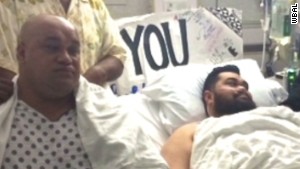New rules give hope to people waiting for donated kidneys
updated 11:23 AM EST, Fri December 5, 2014

Changes in the priorities of the kidney donation waiting list could maximize a scarce resource.
STORY HIGHLIGHTS
- Changes in calculation of waiting list for donor kidneys could maximize small supply of organs
- Fewer than 17,000 kidney transplants are performed a year
- More than 100,000 people need a donated kidney
Sanders, 28, has been on
dialysis for about six years. Lupus, high blood pressure and an
infection caused a kidney to fail. The Georgian already received one
kidney from a living donor in 2009, but her body rejected it the next
year due to a parasite. Working through Emory University Hospital, she's
been waiting for a donated organ ever since. "They said they will call
when there's a match," Sanders said.
Effective Thursday,
changes in the way the waiting list is calculated could work in her
favor, including the length of time she's been on dialysis, her young
age and a couple of other factors. There's hope that call from Emory may come sooner.
Kidneys are a scarce resource. Fewer than 17,000 transplants are performed a year, and there are 101,954 people who need a donated kidney, according to the United Network for Organ Sharing, or UNOS, the organization that runs the system.
 Teen gives kidney, gets help in return
Teen gives kidney, gets help in return
 Ex-NFL player donates kidney to ex-rival
Ex-NFL player donates kidney to ex-rival
 Man wears sign to find wife a kidney
Man wears sign to find wife a kidney
When someone needs a
transplant, he or she is placed on a waiting list. Where someone falls
on that list depends on a wide variety of factors. These shifted with
Thursday's changes. The hope is that the new criteria will help maximize
the benefits from the small pool of donated kidneys available.
Before the changes,
people who were waiting the longest would be higher up on the list. Now
the healthiest of the kidneys will be offered first to patients whom
doctors expect will survive the transplant the longest. The viability of
transplant is determined by the age of the kidney and the kidney
donor's medical history.
Of transplant candidates, almost 15% are waiting for a second transplant because their bodies rejected the first.
Tonya Saffer, senior health policy director at the National Kidney Foundation, explains:
"If you give a 20-year-old a 65-year-old kidney, there is a likelihood
the 20-year-old will have to get another transplant at some point. So
this fixes that," Saffer said. "We will be able to make better use of
kidneys and not have to re-transplant as many people,"
Reducing those transplants means the number of people waiting for kidneys should then go down.
Other revisions include a
shift that helps people who are tough to match because they have higher
levels of antibodies that make them not the best candidate for
transplantation. They move up on the waiting list.
Minority patients who
typically have a blood type of B should benefit from a change in the
policy. The policy widens the pool of blood types that would be a match
for that person.
The number of years
people have been on dialysis will now count toward their time on the
waiting list. But the less time someone spends on dialysis the better
the chance the transplant will take.
The change in dialysis
rules should also help minority patients since studies show as a group
minorities and people in rural areas tend to spend more time on
dialysis.
There will also be a
priority given to living donors. If you gave someone else a kidney and
you need one down the road, you will automatically start higher up on
the list.
The changes are a big shift, according to Saffer.
"It's a big deal. I
think it is definitely an improvement over what the policy is today,"
Saffer said. "No policy is ever going to be completely fair for everyone
because there aren't enough kidneys for everyone who needs one, but
this is a step in the right direction to make sure we are reducing organ
wastage and trying to increase the number of people getting kidneys."
No comments:
Post a Comment